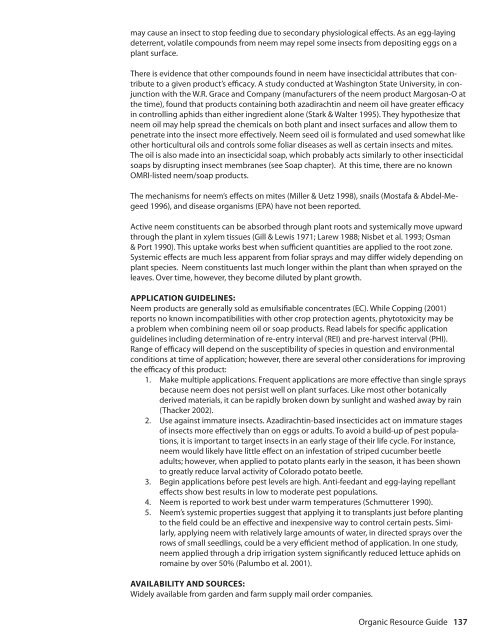Resource Guide for Organic Insect and Disease ... - Cornell University
Resource Guide for Organic Insect and Disease ... - Cornell University
Resource Guide for Organic Insect and Disease ... - Cornell University
Create successful ePaper yourself
Turn your PDF publications into a flip-book with our unique Google optimized e-Paper software.
may cause an insect to stop feeding due to secondary physiological effects. As an egg-laying<br />
deterrent, volatile compounds from neem may repel some insects from depositing eggs on a<br />
plant surface.<br />
There is evidence that other compounds found in neem have insecticidal attributes that contribute<br />
to a given product’s efficacy. A study conducted at Washington State <strong>University</strong>, in conjunction<br />
with the W.R. Grace <strong>and</strong> Company (manufacturers of the neem product Margosan-O at<br />
the time), found that products containing both azadirachtin <strong>and</strong> neem oil have greater efficacy<br />
in controlling aphids than either ingredient alone (Stark & Walter 1995). They hypothesize that<br />
neem oil may help spread the chemicals on both plant <strong>and</strong> insect surfaces <strong>and</strong> allow them to<br />
penetrate into the insect more effectively. Neem seed oil is <strong>for</strong>mulated <strong>and</strong> used somewhat like<br />
other horticultural oils <strong>and</strong> controls some foliar diseases as well as certain insects <strong>and</strong> mites.<br />
The oil is also made into an insecticidal soap, which probably acts similarly to other insecticidal<br />
soaps by disrupting insect membranes (see Soap chapter). At this time, there are no known<br />
OMRI-listed neem/soap products.<br />
The mechanisms <strong>for</strong> neem’s effects on mites (Miller & Uetz 1998), snails (Mostafa & Abdel-Megeed<br />
1996), <strong>and</strong> disease organisms (EPA) have not been reported.<br />
Active neem constituents can be absorbed through plant roots <strong>and</strong> systemically move upward<br />
through the plant in xylem tissues (Gill & Lewis 1971; Larew 1988; Nisbet et al. 1993; Osman<br />
& Port 1990). This uptake works best when sufficient quantities are applied to the root zone.<br />
Systemic effects are much less apparent from foliar sprays <strong>and</strong> may differ widely depending on<br />
plant species. Neem constituents last much longer within the plant than when sprayed on the<br />
leaves. Over time, however, they become diluted by plant growth.<br />
APPLICATION GUIDELINES:<br />
Neem products are generally sold as emulsifiable concentrates (EC). While Copping (2001)<br />
reports no known incompatibilities with other crop protection agents, phytotoxicity may be<br />
a problem when combining neem oil or soap products. Read labels <strong>for</strong> specific application<br />
guidelines including determination of re-entry interval (REI) <strong>and</strong> pre-harvest interval (PHI).<br />
Range of efficacy will depend on the susceptibility of species in question <strong>and</strong> environmental<br />
conditions at time of application; however, there are several other considerations <strong>for</strong> improving<br />
the efficacy of this product:<br />
1. Make multiple applications. Frequent applications are more effective than single sprays<br />
because neem does not persist well on plant surfaces. Like most other botanically<br />
derived materials, it can be rapidly broken down by sunlight <strong>and</strong> washed away by rain<br />
(Thacker 2002).<br />
2. Use against immature insects. Azadirachtin-based insecticides act on immature stages<br />
of insects more effectively than on eggs or adults. To avoid a build-up of pest populations,<br />
it is important to target insects in an early stage of their life cycle. For instance,<br />
neem would likely have little effect on an infestation of striped cucumber beetle<br />
adults; however, when applied to potato plants early in the season, it has been shown<br />
to greatly reduce larval activity of Colorado potato beetle.<br />
3. Begin applications be<strong>for</strong>e pest levels are high. Anti-feedant <strong>and</strong> egg-laying repellant<br />
effects show best results in low to moderate pest populations.<br />
4. Neem is reported to work best under warm temperatures (Schmutterer 1990).<br />
5. Neem’s systemic properties suggest that applying it to transplants just be<strong>for</strong>e planting<br />
to the field could be an effective <strong>and</strong> inexpensive way to control certain pests. Similarly,<br />
applying neem with relatively large amounts of water, in directed sprays over the<br />
rows of small seedlings, could be a very efficient method of application. In one study,<br />
neem applied through a drip irrigation system significantly reduced lettuce aphids on<br />
romaine by over 50% (Palumbo et al. 2001).<br />
AVAILABILITY AND SOURCES:<br />
Widely available from garden <strong>and</strong> farm supply mail order companies.<br />
<strong>Organic</strong> <strong>Resource</strong> <strong>Guide</strong> 137







